Cyborg ransomware is the threat that gets loaded on the machine via fraudulent Windows update notification emails
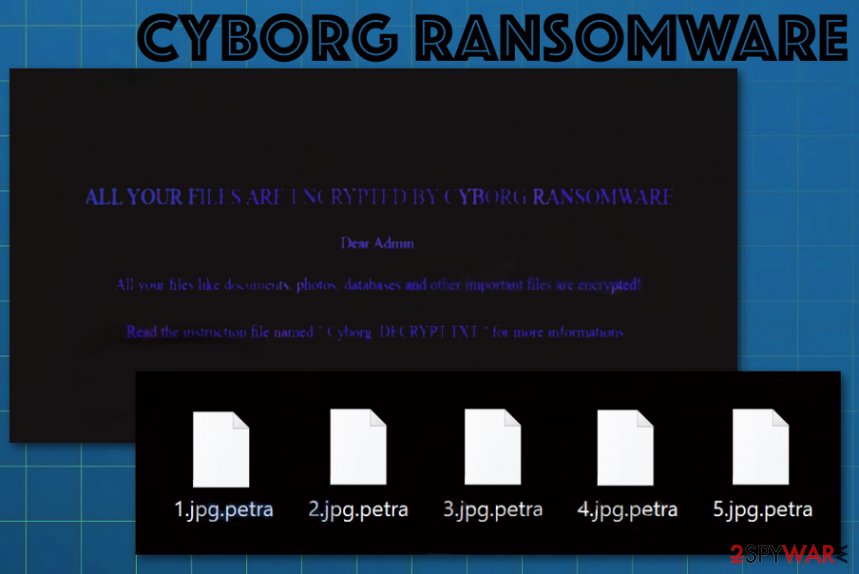 Cyborg ransomware is the threat that marks encrypted files using .petra file appendix and gets installed on the PC from an email about needed updates. The email notification with “Install the latest Update now” tricks people into prompting the Critical Microsoft Windows Update install that triggers an executable file named bitcoingenerator.exe. Hidden behind the .jpg type of the file, this executable launches the ransomware payload on the system immediately.
Cyborg ransomware is the threat that marks encrypted files using .petra file appendix and gets installed on the PC from an email about needed updates. The email notification with “Install the latest Update now” tricks people into prompting the Critical Microsoft Windows Update install that triggers an executable file named bitcoingenerator.exe. Hidden behind the .jpg type of the file, this executable launches the ransomware payload on the system immediately.
The threat first was spotted at the beginning of November, but the particular Cyborg ransomware virus campaign that reportedly[1] involves .777 file marker and those emails with Windows 10 updates, was discovered in the middle of the same month. When malware is done encoding files, it deletes itself, places a copy of the virus as a file bot.exe in the root of the infected device, and a typical ransom note file in the text file named Cyborg_DECRYPT.txt on the desktop and in various folders with affected data. The message is generated for virus victims, so they can know what to do next. Unfortunately, the option malware creators suggest involves paying the ransom for the alleged decryption tool that is not the best solution, as previous incidents show.[2]
| Name | Cyborg ransomware |
|---|---|
| File marker | .petra, .777 marks all files encrypted by the virus and indicates useless data |
| Distribution | Infected email attachments with malicious files, fake updates promoting messages, torrent sites, pirated software, malicious files, other malware set to deliver crypto-extortion based threats |
| Ransom note | Cyborg_DECRYPT.txt – a text file containing the message from virus developers where hackers suggest victims paying up as soon as possible to get their files back supposedly |
| Ransom amount | Cybercriminals demand at least $300 in Bitcoin. Some campaigns reported about ransom amount going up to $500 for the alleged decryption key |
| Contact emails | petra-mail.ru, [email protected] |
| Danger | Such money-oriented threat actors don’t care for your belongings, so the main focus is encryption and ransom demands. There is no guarantee that paying could ensure file recovery, so you pay for nothing in the long run and can lose your files permanently. Also, ransomware can load additional scripts and affect the machine further when the encryption is already done |
| Elimination | For a proper Cyborg ransomware removal, you should get anti-malware tool and run on the machine to fully find and eliminate malicious files, programs, the initial virus |
| Tips for system recovery | Besides encrypting your personal data like photos, documents, or archives, Cyborg ransomware virus can alter system settings and important parts like directories or startup preferences. You should try to fix the virus damage and repair system data using a system tool like Reimage Reimage Cleaner |
Cyborg ransomware gets dropped when spam campaign tricks people into script delivery by claiming that the email is sent from Microsoft officials and encourages to install the latest Windows 10 update. The fake update attachment is an executable file even though .jpg file extension is on the filename. In reality, the malicious .NET file is an executable that downloads malware on the infected system and triggers a file encryption process.
According to people who managed to tool more into the attack, this mid-November Cyborg ransomware campaign appended all the files with .777 extension and loaded the ransom note on the compromised machine’s Desktop. Cyborg_DECRYPT.txt provided information about the ransom amount – $500 in Bitcoin that should be sent to the particular wallet provided on the text file already.
Cyborg ransomware shows a message on the Desktop directly that replaces the wallpaper, but that picture contains only information about encrypted files and notes that the full ransom message placed as a text file. The ransom message seems to be generated as any typical message from crypto-extortionists, so don’t trust them and try to react as soon as possible by eliminating the threat and ignoring the following or a similar note entirely:
———————— ALL YOUR FILES ARE ENCRYPTED BY CYBORG RANSOMWARE ————————
Don’t worry, you can return all your files!
All your files like documents, photos, databases and other important are encrypted
What guarantees do we give to you?
You can send one of your encrypted file and we decrypt it for free.
You must follow these steps To decrypt your files :
1) Send $300 bitcoin to wallet :9e3d4e3fad796f4eb15962b74fb2e55fe47
2) write on our e-mail :petra-mail.ru
Your personal ID :
Also, a second step after the payment should be writing an email to the described email address. However, we don’t recommend paying or contacting criminals. You should ignore the message instead and remove Cyborg ransomware from the machine until the PC gets damaged permanently.
Cyborg ransomware message encourages you to contact a new email address – [email protected] that also seems to be related to Russia as a previous petra-mail.ru, but there is no relation to any hacking groups that could be confirmed. Nevertheless, the message should be ignored, and the machine cleaned as soon as possible if you want to get back to the virus-free machine. 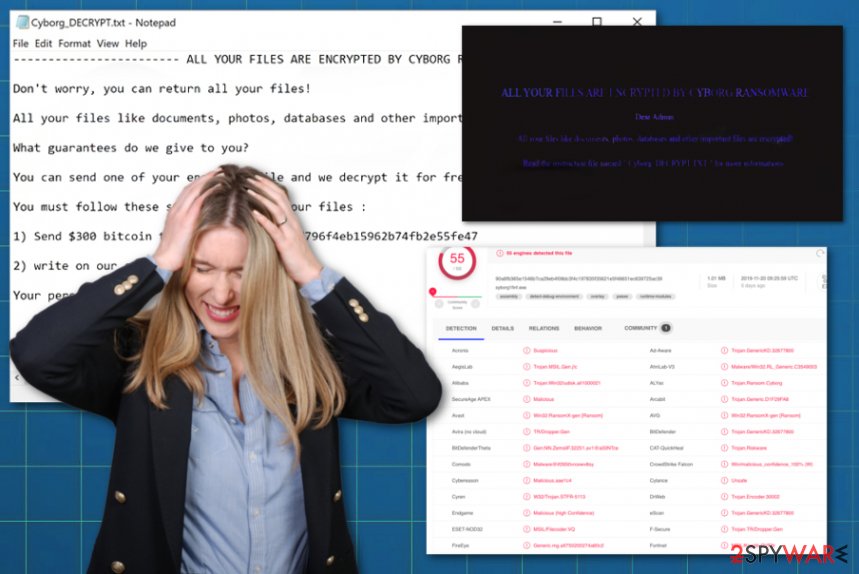
Cyborg ransomware is the malicious program that gets hidden behind processes on the Microsoft system, so files can get encrypted. At least three different samples got investigated, but there is not enough information to state that Cyborg ransomware is decryptable or belongs to a particular virus family. There is a tool called Cyborg Builder ransomware, so there might be more news about the threat in the future. But the builder contains a link to the Russian version of the same builder on another website beside GitHub.
Researchers report that Cyborg ransomware can be created and spread by anyone who can obtain the builder. It can be spread using various forms of gateways and spamming campaigns. This is a crafted cryptovirus that uses random extensions to mislead victims from identifying the particular strain.
It means that Cyborg ransomware removal may become a huge issue and a question among online users when more and more people will get victimized. Experts[3] also note that cybercriminals who deliver threats like this can only worry about their own benefits, so trusting anyone is a bad choice, even though the ransom note creates trust between you and the developer.
Also, since Cyborg ransomware is a virus that hides all over the computer system, you should check important parts of the system with PC repair tools, system applications like Reimage Reimage Cleaner . This software may indicate corrupted, damaged, or outdated files in folders of your system like directories, registry. Even when you get rid of the malware itself, virus damage can cause more issues, so you need to take care of everything to get back to work on the safe computer. Additional tips for your data recovery can be found below the article. 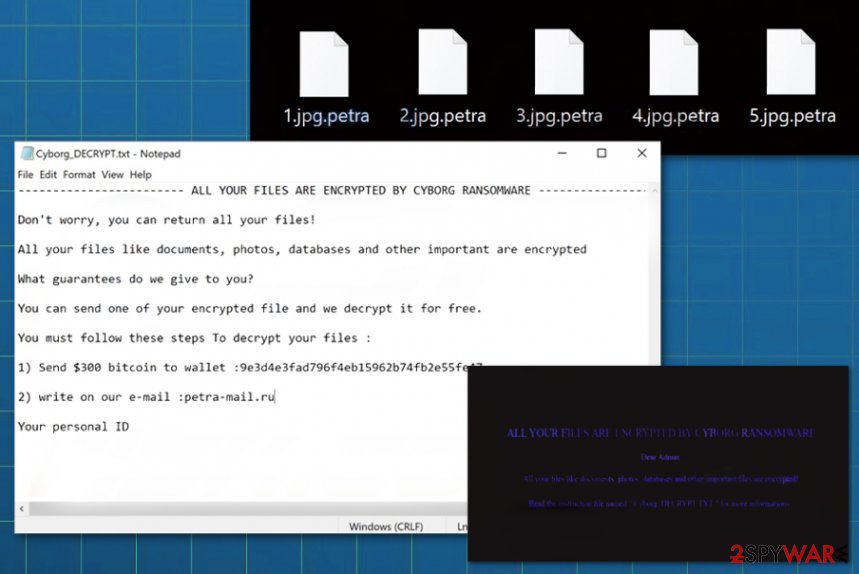
Cyborg ransomware is the infection making files useless and marking them with .petra or .777 file extension.
Infected email attachments get hidden behind scary or legitimate-looking email subject lines
Don’t fall victim to scamming campaigns by paying close attention to processes and learning to look for red flags. Targeted users in various campaigns receive emails with either the subject line about financial information or, in this case, windows update message.
“Install Latest Microsoft Windows Update now!” or “Critical Microsoft Windows Update!” statements should already be suspicious since Windows Updates are not pushed through emails. Your operating system should indicate that there is an update you may need to install. So this is a red flag number one – a common type of email and the sender.
These particular emails contain notifications like “Please install the latest critical update from Microsoft attached to this email” and attachments that have an easily triggered executable. You only need to download the file, and malicious scripts can do whatever developers designed them for.
How to avoid such infection? Be cautious about such malicious emails, and look for red flags, be more suspicious and cautious, delete anything that is not familiar, or creates questions. Clean the email message more often and delete emails that get there without expectations.
Terminate Cyborg ransomware using professional AV tools and make sure to repair virus damage
To fully eliminate a threat like Cyborg ransomware virus, it is important to know more about the type of malware you got affected by. There is no one cure for cyber infections, even though anti-malware programs can eliminate most of them, there are additional processes and tips you need to remember.
Since this is the crypto-extortion based malware, paying is not the option for Cyborg ransomware removal. Even when you pay the ransom and your files get recovered, the system is still infected and damaged. To get your compromised device to work properly again, you need to clean the system entirely.
The best tool for you that we can recommend is anti-malware software – programs that work on particular malware databases that can indicate malicious activities for you should also remove Cyborg ransomware. Unfortunately, removing the virus is not going to recover your encrypted data or fix damaged parts of the system. Additional steps after the virus removal:
Remove Cyborg using Safe Mode with Networking
Reboot the machine in Safe Mode with Networking to fully eliminate Cyborg ransomware virus
- Windows 7 / Vista / XP
- Click Start → Shutdown → Restart → OK.
- When your computer becomes active, start pressing F8 multiple times until you see the Advanced Boot Options window.
- Select Safe Mode with Networking from the list
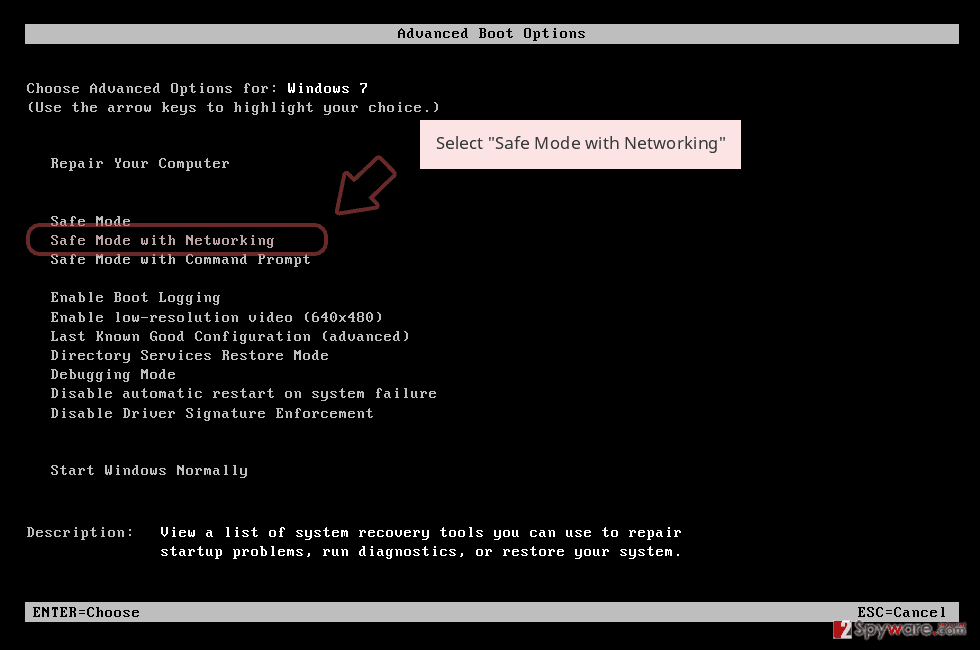
Windows 10 / Windows 8
- Press the Power button at the Windows login screen. Now press and hold Shift, which is on your keyboard, and click Restart..
- Now select Troubleshoot → Advanced options → Startup Settings and finally press Restart.
- Once your computer becomes active, select Enable Safe Mode with Networking in Startup Settings window.
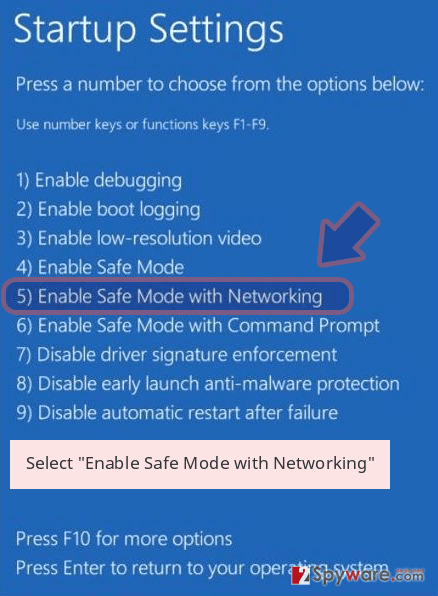
-
Log in to your infected account and start the browser. Download Reimage Reimage Cleaner or other legitimate anti-spyware program. Update it before a full system scan and remove malicious files that belong to your ransomware and complete Cyborg removal.
If your ransomware is blocking Safe Mode with Networking, try further method.
Remove Cyborg using System Restore
System Restore is the feature that helps with ransomware since it can recover machine in a previous state
Bonus: Recover your data
Guide which is presented above is supposed to help you remove Cyborg from your computer. To recover your encrypted files, we recommend using a detailed guide prepared by 2-spyware.com security experts.
If your files are encrypted by Cyborg, you can use several methods to restore them:
Data Recovery Pro should be a helpful program that acts as an alternative for file backups
Data Recovery Pro works for encoded and accidentally deleted files, so you restore them
- Download Data Recovery Pro;
- Follow the steps of Data Recovery Setup and install the program on your computer;
- Launch it and scan your computer for files encrypted by Cyborg ransomware;
- Restore them.
Windows Previous Version is the method for recovering individual files
When System Restore gets enabled, you can use Windows Previous Versions and recover affected data
- Find an encrypted file you need to restore and right-click on it;
- Select “Properties” and go to “Previous versions” tab;
- Here, check each of available copies of the file in “Folder versions”. You should select the version you want to recover and click “Restore”.
ShadowExplorer is the feature helpful for encoded files
When Shadow Volume Copies are left untouched, ShadowExplorer can be a helpful option for data recovery
- Download Shadow Explorer (http://shadowexplorer.com/);
- Follow a Shadow Explorer Setup Wizard and install this application on your computer;
- Launch the program and go through the drop down menu on the top left corner to select the disk of your encrypted data. Check what folders are there;
- Right-click on the folder you want to restore and select “Export”. You can also select where you want it to be stored.
Decryption for files affected by Cyborg ransomware is not possible yet
Finally, you should always think about the protection of crypto-ransomwares. In order to protect your computer from Cyborg and other ransomwares, use a reputable anti-spyware, such as Reimage Reimage Cleaner , SpyHunter 5Combo Cleaner or Malwarebytes
This entry was posted on 2019-11-25 at 08:06 and is filed under Ransomware, Viruses.

